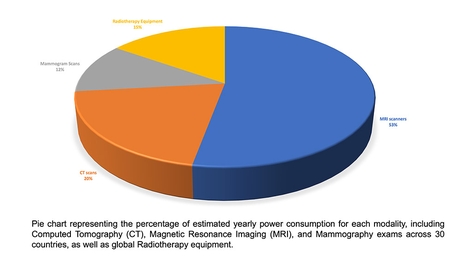Understanding the environmental footprint of radiology and radiation oncology may help clinicians, hospital administrators and policymakers reach environmentally sensitive decisions.
“Implementing energy-efficient practices could significantly reduce operational costs in health care facilities,” said Shakthi Kumaran Ramasamy, MD, a postdoctoral research fellow in the Department of Radiology at Stanford University School of Medicine in California. “This cost savings could then be redirected to enhance patient care and invest in advanced medical technologies, potentially improving the quality of patient care and outcomes.”

Ramasamy
To shed light on the environmental impact of radiology and radiation oncology equipment, Dr. Ramasamy sought to quantify the global energy consumption of these essential health care devices. He gathered and consolidated data from a broad range of sources, including the World Health Organization, the Organization for Economic Co-operation and Development, and regional health databases, to estimate global distribution and types of devices in use in 30 countries.
This estimate considered the number of CT scanners, MRI units, mammography machines and radiotherapy equipment per 1 million inhabitants. Dr. Ramasamy obtained energy consumption metrics and estimated usage hours from manufacturers and through scientific literature.
“One major setback in this study was gathering relevant information for this global estimate, as there are no established guidelines on how to approach this task,” Dr. Ramasamy said. “Surprisingly, I found a lack of published literature on the topic during my background research. Additionally, data availability was a significant issue, particularly because information about radiology equipment in some countries is not readily accessible or does not exist.”
Energy-Efficient Equipment, Schedule Optimization Key to Mitigation
Dr. Ramasamy estimated that the combined total number of CT and MRI exams from 30 countries is approximately 278 million exams annually. “Collectively, these exams consume an estimated 2308.65 million kilowatt-hours of energy per year,” Dr. Ramasamy said. “MRI scanners emerged as the dominant contributors to the total energy consumption.”
The research highlights the substantial energy consumption of these machines and the need to develop strategies to mitigate their environmental impact. These may include procuring energy-efficient machines, optimizing usage schedules and endorsing renewable energy sources.
“The total CO2 emissions from the power consumption of CT and MRI exams and mammography exams across 30 countries and global radiotherapy equipment amount to approximately 1,419,784 tons of CO2,” Dr. Ramasamy said. “This is roughly the equivalent of between 417,261 and nearly 1.5 million long-haul airline flights, depending on the specific flight and calculation parameters used.”
Dr. Ramasamy emphasized the critical role of energy management in medical equipment, with a particular focus on MRI machines. “About 25% to 40% of the total energy consumption of these machines occurs during idle periods, mainly at night and on weekends,” he said. “This indicates that active scanning accounts for less than half of their total energy usage, highlighting a significant opportunity for energy-saving strategies in health care facilities.”
Additionally, Dr. Ramasamy said that these efforts could contribute to wider environmental sustainability goals and meet the increased demand from patients and the public for environmentally responsible health care practices. “This could lead to a paradigm shift in health care operations, integrating sustainability as a fundamental aspect of clinical decision-making and health care management,” he said.


Access the presentation, "A Global Assessment of Energy Consumption in Radiology and Radiation Oncology: An Environmental Impact Study,” (T3-STCE1-3) on demand at Meeting.RSNA.org .

